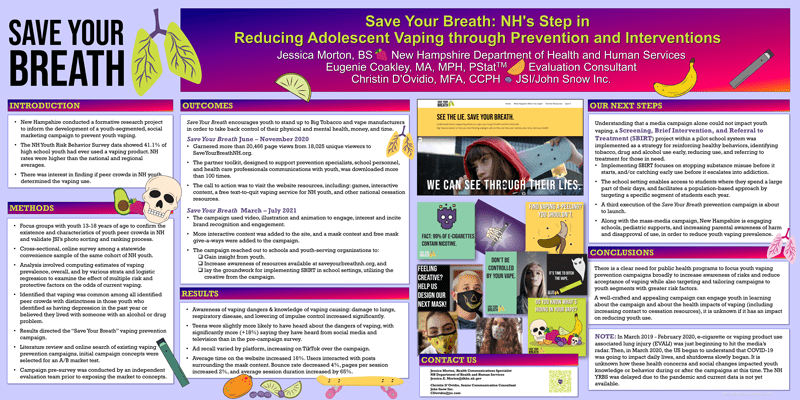Save Your Breath: NH Works to Reduce Adolescent Vaping
June 27th, 2022 | news
In partnership with the NH Department of Health and Human Services (DHHS), we completed this formative research project to conduct for development of a youth-segmented, social marketing campaign for vaping prevention. The Program was particularly interested in whether vaping varied among NH youth by peer crowd, and aspects of behavioral health.
Our team conducted focus groups with youth 13-18 years of age to confirm the existence and characteristics of youth peer crowds in NH and validate JSI’s photo sorting and ranking process. Then, a cross-sectional, online survey was completed among a statewide convenience sample of the same cohort of NH youth. The analysis of all this data involved computing estimates of vaping prevalence, overall, and by various strata and logistic regression to examine the effect of multiple risk and protective factors on the odds of current vaping. The project identified that vaping was common among all identified peer crowds. Vaping was distinctly prevalent in youth who identified as having depression in the past year or believed they lived with someone with an alcohol or drug problem.
The resulting data from this project informed the creation of the Save Your Breath vaping prevention campaign. Save Your Breath ran statewide from June – November 2020 and again from March – July 2021 on social/digital platforms. Pre- and post-campaign surveys were independently conducted to assess effectiveness and ad recall. Additional outreach was made to schools and youth-serving organizations to gain insight from the youth themselves, increase awareness of resources available for health information and cessation, and lay the groundwork for implementing screening and brief intervention and referral to treatment (SBIRT), or 2As and R, in school settings, utilizing the creative from the campaign.
There is a clear need for public health programs to focus youth vaping prevention campaigns broadly to increase awareness of risks and reduce acceptance of vaping, while also targeting and tailoring campaigns to youth segments with greater risk factors. A well-crafted and appealing campaign can engage youth in learning about the health impacts of vaping.

Our team conducted a formative research project to inform the development of a youth-segmented, social marketing campaign to prevent youth vaping and determine the existence of and percent of peer crowds in NH who are vaping.
In 2019, primary data collection was via web-based survey to ascertain vaping behavior & knowledge, attitudes and beliefs, peer crowd affiliation, mental health, interests, and demographics of NH youth. Vaping was very common; 60% of respondents had vaped at least once in their lifetime. The overall vaping rates, segmented by peer crowd, were similarly very high, due to the confounding factors of depression and perception of ever living with someone with an alcohol or drug problem. When neither risk factor, mental health (MH) or substance use (SU), was present, vaping prevalence varied. Among youth for whom both risk factors were present, vaping prevalence was over 80% for nearly all peer crowds. The exception, at ~70%, was the “Country” peer crowd.

Our team conducted a formative research project to inform the development of a youth-segmented, social marketing campaign to prevent youth vaping and determine the existence of and percent of peer crowds in NH who are vaping.
In 2019, primary data collection was via web-based survey to ascertain vaping behavior & knowledge, attitudes and beliefs, peer crowd affiliation, mental health, interests, and demographics of NH youth. Vaping was very common; 60% of respondents had vaped at least once in their lifetime. The overall vaping rates, segmented by peer crowd, were similarly very high, due to the confounding factors of depression and perception of ever living with someone with an alcohol or drug problem. When neither risk factor, mental health (MH) or substance use (SU), was present, vaping prevalence varied. Among youth for whom both risk factors were present, vaping prevalence was over 80% for nearly all peer crowds. The exception, at ~70%, was the “Country” peer crowd.
Overall, the results from this survey helped us to identify the need for a social-marketing campaign with a focus around developing messaging to address the needs of youth who are experiencing mental health and substance use disorders.
Learn more about our Health Communications expertise.
We strive to build lasting relationships to produce better health outcomes for all.